| |
|
| Read about the disastrous
1918 outbreak of 'Spanish Flu'. |
 |
| |
|
|
The
Economy
Immediately after the end of the
First World War, there was a short-lived boom in the
economy, which lasted until late in 1919, but things
rapidly changed. The early 1920s were a time of
recession, a time of hardship for many people. The First
World War greatly stretched the nation’s finances. It
disrupted our trade, and led to the rise of foreign
competition, and the loss of many of our traditional
exports, including steel, coal, and textiles. The
country had previously grown wealthy because of its
pre-eminent trading position in the world, the loss of
which, led to the decline of many of our once great
industries, and substantial job losses. In 1922 there
were 9,457 people out of work in Walsall alone.
The war had been funded by selling
foreign assets, and borrowing large sums of money, which
led to a large national debt. Britain’s interest
payments amounted to around forty percent of the
national budget. In 1920 the rate of inflation was twice
as high as in 1914, and the value of the pound fell. |
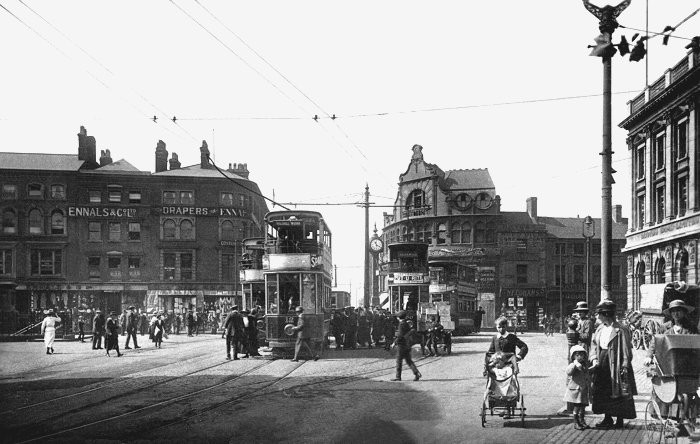 The Bridge in the early 1920s. From an old
postcard.
The Bridge in the early 1920s. From an old
postcard.
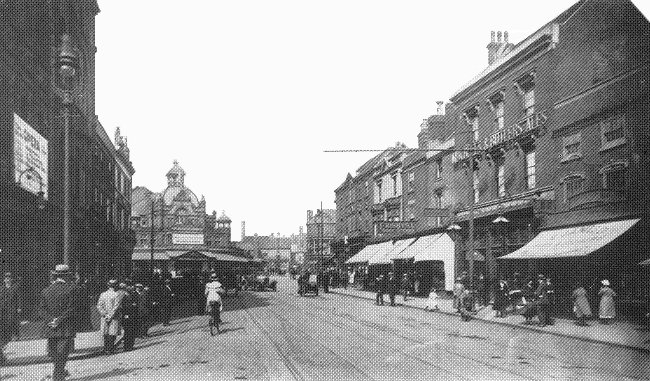 Park Street in around 1925. From an old
postcard.
Park Street in around 1925. From an old
postcard.
|

A carnival float in Pleck Road in
the 1920s. Courtesy of Christine and John Ashmore. |
 |
Another carnival float in
Pleck Road in the 1920s. Courtesy of Christine and John
Ashmore. |
|
Homes for All
By 1921 the population of Walsall
had reached 169,406. This led to a desperate housing
shortage, made worse because no houses had been built in
the borough since before the war. Private builders could
not afford to provide the necessary homes, which
immediately after the war were costing between £1,000
and £1,200 to build. Ironically this sum fell to a
little over £300 within ten years.
The housing shortage was a national
problem and so the Government provided subsidies for
local authorities, who were now required to provide
housing under the terms of the 1919 Housing Act. Walsall
Council started its municipal housing scheme in 1920
under the control of the Health Committee, but as
demands grew, a special Housing Committee was appointed.
The first council houses were built
in Blakenall Lane and Haskell Street in 1920, the first
to be completed being numbers 94 and 96 Blakenall Lane,
now opposite Blakenall United Reformed Church. By 1927 a
total of 450 houses had been built on the Blakenall
estate.
By 1935 there were over 5,400
council houses in the town, each with a bathroom and a
garden. There were non-parlour types with three
bedrooms, and a few with four. There were parlour types
with three bedrooms, a sitting room, and a living room.
The houses were distributed as follows:
| Blakenall and
Harden – 1,100 |
| Palfrey – 1,000 |
| Field Road – 963 |
| Wolverhampton
Road, Pleck and Bentley – 850 |
| Bloxwich and
Leamore – 700 |
| Fullbrook and
Delves – 400 |
| North Walsall –
350 |
| Chuckery and the
central area – 100 |
| Homes for old
people – 78 |
|
|
In 1935 the charge on the general
rates for council houses was £23,675, with a capital
cost of £2,093,209, and weekly rents amounting to
£2,500. In March of that year the 5,000th council house
was completed at 11 Walstead Road West, and by the end
of the 1930s 7,963 council houses had been built.
Some of the houses were built as a
result of the 1930 Housing Act which encouraged mass
slum clearance, and the removal of poor quality housing.
Houses were demolished in James Street and Ann Street in
Ryecroft, and in Short Acre Street, and Long Acre
Street. This was followed by the clearance of slums in
Peal Street, Dudley Street, Lower Rushall Street, and Upper Rushall Street.
In 1937 many of the old
buildings in Digbeth were demolished, and new council
houses were provided for the occupants, in Field Road, Fullbrook, Mill Lane,
and Moat Road.
Unemployment and strikes
By the mid 1920s many industries
were still suffering, particularly after the decision in
1925 keep Britain in the Gold Standard, so that the
pound was equal to 4.85 dollars. This led to high
interest rates, and over-priced exports.
One of the country’s most important
industries, coal mining, had been in decline since the
start of the First World War, and many miners were
laid-off. The heavy use of coal during the war led to
the depletion of many seams, so that when the war ended,
Britain exported less coal, allowing other countries
including the United States, Germany, and Poland, to
fill the gap. In 1924 coal prices fell because of the
Dawes Plan, which had been designed to set targets for
German reparation payments. As part of the payment,
Germany was allowed to export coal to France and Italy,
which led to a further decline in the UK mining
industry. In 1926, mine owners announced their intention
to further reduce miner’s pay, and lengthen their
working day. Negotiations between the TUC and the mine
owners, failed to reach an agreement,
and so the TUC called a general strike to support the
miners, which was to begin on 3rd May. |
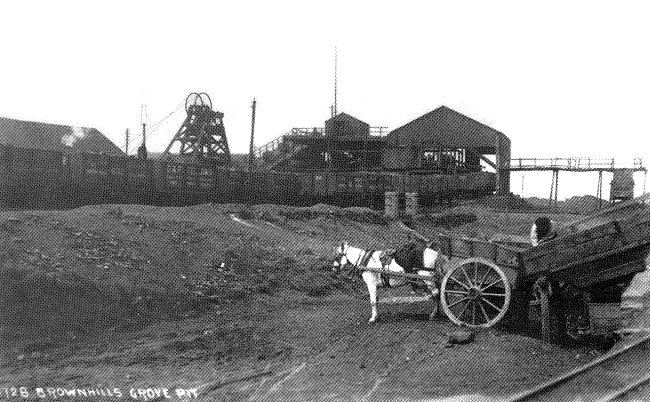 One of Walsall's deep coal mines, Grove
Pit at Brownhills. From an old postcard.
One of Walsall's deep coal mines, Grove
Pit at Brownhills. From an old postcard.
|
Large numbers of people from all
industries joined the strike, which quickly paralysed
much of the country. In Walsall there was no public
transport because trains, trams, and buses were out of action.
Hundreds of strikers filled the town centre, and strike
bulletins were posted outside the Labour Club in
Bradford Street. An emergency committee was formed to
oversee the distribution of essential supplies, and
around 1,000 people signed-up as volunteers to help.
Three hundred and fifty special constables were sworn-in
to be ready in case of lawlessness, but it all went-off
peacefully, with little violence. The strike ended on
12th May, although the miners battled-on until November,
when their strike collapsed.
The strike led to lack of orders,
and a depression in many local industries. Around 2,300
workers were laid-off, including 500 in the leather
trades. Some less fortunate strikers were not given their
jobs back on their return to work,
particularly in public transport. People laid-off were
entitled to benefit from the Poor Law Guardians, and
further help was provided by a distress fund.
The families of striking miners
suffered greatly. By June, around 2,600 miner’s children
were being fed at soup kitchens throughout the town.
They were located at:
The Turf Tavern, Bloxwich; Field
Street School, Bloxwich; the Blue Pig Inn, Bloxwich;
Blakenall Church School; the Nag’s Head, Little
Bloxwich; the White Horse Inn, Green Lane; and John
Street School.
Committees were set up in Aldridge
and Pelsall to help, and hundreds of people scoured
Bentley Common, and the old spoil heaps around Pleck to find coal for heating. Although many
of Walsall’s industries had suffered as a result of the
strike, and unemployment was high, things slowly
improved, albeit briefly.
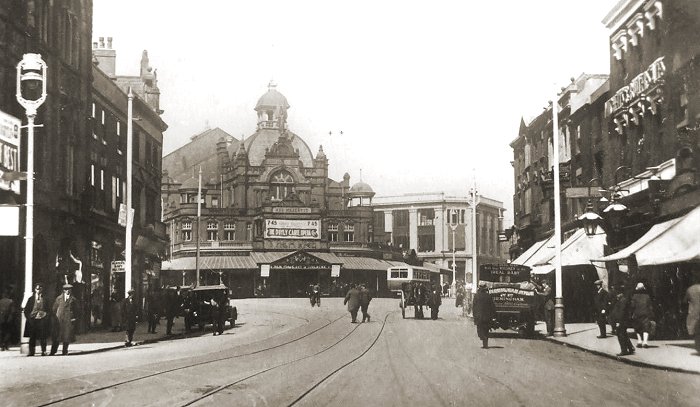
The top of Park Street in the
1930s. From an old postcard.
By the late 1920s, the United
Kingdom had still not recovered from the effects of the
First World War. Production was still below previous
levels, and many people were out of work. Everything
suddenly got worse after 1929 as a result of the stock
market crash in New York which affected much of the
world. The demand for British products fell, so much so
that by the end of 1930 unemployment more than doubled,
from one million to two and a half million, and exports
halved.
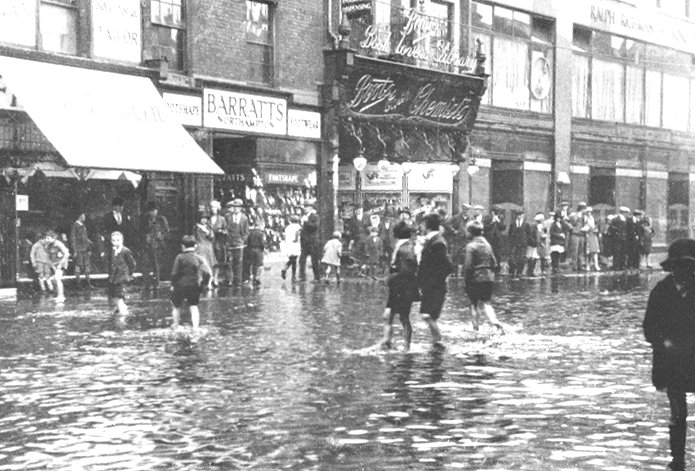
Park Street under water in June
1931.
The unemployed had to seek
financial help from the Public Assistance Committee
which means-tested applicants before allowing them to
receive benefit. In order to help families in distress,
Walsall Council introduced a scheme to provide
two-course midday meals for needy schoolchildren. By
February 1934, free meals were being provided for 500
children, six days a week. Things didn’t really improve
until the years immediately before the Second World War,
when industry began to ramp-up, thanks to the orders
that were received
for essential war work.

Lichfield Street and the Town
Hall. From an old postcard, courtesy of Christine and
John Ashmore.
Council Projects
Walsall Council attempted to help
the many people who were out of work by instigating
public works schemes for the unemployed. The schemes
included the building of the open air swimming pool at
Bloxwich, the levelling of Blakenall playing fields, and
improvements to the Arboretum, including the upgrading of
the open-air baths, an extension to the children’s
playground, a putting green, new footpaths, and more
tennis courts. The Rock Gardens were added in 1924 along
with tubular swings, and a merry-go-round. |
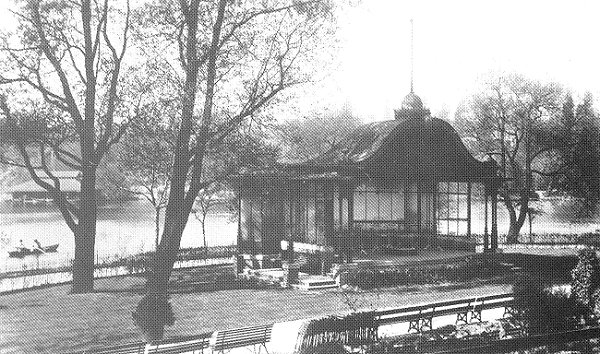 |
The bandstand in the arboretum
in the late 1920s. From
an old postcard. |
|
A number of road improvements were
also carried out to help the unemployed. The most
important was the building of the new road from Foden
Road to Bescot Road, which was originally called the
Ring Road. In 1931 when the borough was extended, with
the addition of an area to the north and west, including
part of Bentley, the road name was changed to Broadway.
Several roads were widened including Lichfield Road in
Bloxwich, Aldridge Road, Bloxwich Road, Bridge Street,
and Sutton Road.
In 1930 the council decided to
spend £224,000 on public works, including a new
swimming baths, an abattoir and cold storage facilities,
an extension to Ryecroft Cemetery, and improvements to
sewage, drainage, and public parks.
By 1931 the population of Walsall
had grown to 181,114, and 30 percent of the workforce
was unemployed.
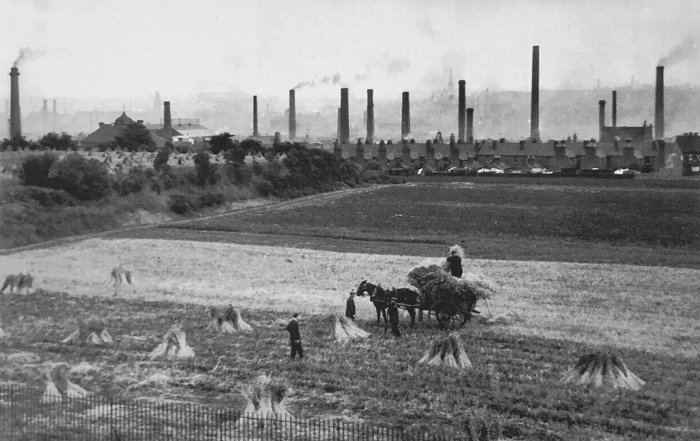
A 1934 view of Craddock's Farm at
Pleck looking towards the town centre. From an old
postcard.
| |
|
View some
photographs of a parade
of works' bands from the 1930s |
 |
Transport
|
|
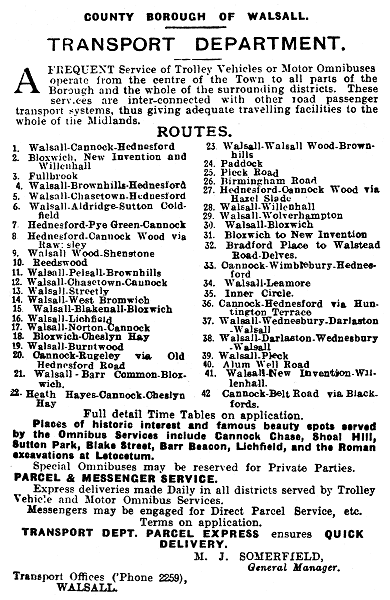
From 1935. |
In the 1930s two branches of the
Wyrley and Essington Canal closed, due to the declining
mining industry. The first, the Lord Hay's Branch
(also spelled Lords Hayes Branch), was
abandoned in 1930. It ran from Fishley to the Lords Hayes
coal pits in Essington.
The second, the Daw End branch
ceased to be used in the late 1930s. It ran from Catshill Junction, Walsall Wood, to the Hay Head
limestone quarries. In 1954 both were filled-in .
On the railways, North Walsall
Station built by the Wolverhampton and Walsall Railway
in 1872, and operated by the Midland Railway from 1876,
closed in 1925. It stood just to the west of Bloxwich
Road.
In 1928 motor buses began to
replace the trams, which ceased running in 1933. Trolley
buses were introduced in 1931 on the Willenhall route,
and the central bus station, on the site of the former
Blue Coat School in St. Paul's Street, opened in 1935.
It was built after the Bluecoat School moved to
Springhill Road in 1933.
|
|
The same year saw the opening of
Walsall Municipal Aerodrome on 230 acres of land beside
Aldridge Road, south of Aldridge. It had a short runway
just 900 yards long, much too short for the larger
aircraft of the day. It also had a considerable slope,
being situated on the side of Beacon Hill, the highest
ground in the area. The official opening took place on
6th July, 1935.
In 1938, Helliwells Limited, a firm
specialising in the repair and maintenance of aircraft,
and the manufacture of aircraft components leased a
large factory on the site from the Corporation. They
opened a flying school in 1943, and also manufactured
motorcycle sidecars, motor scooters, and sports cars
using the 'Swallow' name. |
| |
|
|
|
|
| Read about
Swallow Motor Scooters |
 |
|
Read about
Swallow Sports Cars |
 |
| |
|
|
|
|
|
The aerodrome became the
headquarters of the South Staffordshire Aero Club
(previously known as Walsall Aeroplane Club) which had 50
flying members and 100 non-flying members. A club house
with a bar and small office was built on the site, along
with a hangar, large enough to house four or five small
aircraft. The council employed an aerodrome manager, who
also acted as a ground engineer.
A number of events were held at the
aerodrome including a sailplaning display featuring
gliders that were towed into the air by powered
aircraft, or a winch. The event took place on 26th June,
1938 and starred the well-known female aviator, Amy
Johnson, who made two fights, one in a Kirby Kite
glider, and another in a Gull sailplane.
The event attracted about 6,000
paying spectators, many of whom came to see Amy. On her
second flight as she returned to land, she caught a wing
tip on the perimeter fence, which caused the glider to
flip over. Luckily she was unhurt, although somewhat shaken. She quickly returned to the house of her
friend, John V. Rushton (known as Jack) at 134 Mount Road, Penn,
Wolverhampton, where she was staying. Jack Rushton was
the chief instructor at the Midland Gliding Club. |

From an old postcard. |
|

Amy Johnson. |
|
The aerodrome was the scene of
another crash landing a few weeks later. On 14th July an
RAF Harrow twin-engined bomber on a flight from
Driffield to Southampton attempted to land on the
runway, which was far too short for an aircraft of that
size. It overshot the runway and came to rest in a
hedge, just off Longwood Lane. Luckily the pilot, a
local man, Pilot Officer R. N. Haynes was unhurt.
Unfortunately he was killed three months later in an
identical aircraft which came down in the Channel.
The Aero Club survived until the
beginning of the Second World War, and was not revived
afterwards. In the late 1940s Walsall Council considered
enlarging the airfield and extending the runway, but as
Birmingham and Wolverhampton were extending their
airfields, it was felt that such a project could not be
viable.
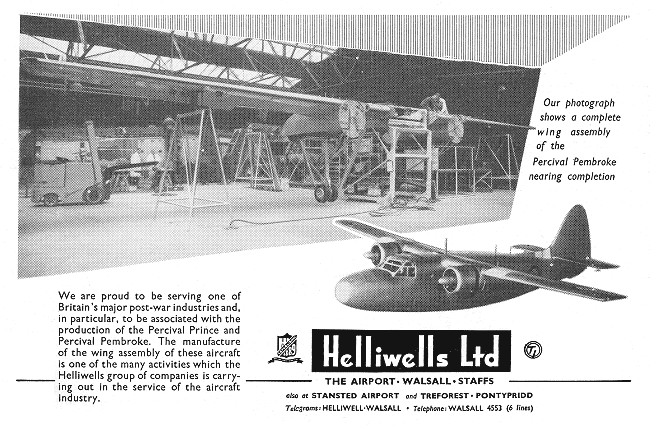
An advert from 1954.

Walsall Airport and Helliwells
factory.
In the 1950s the airfield was
mainly used by Helliwells for aircraft servicing, the
production of aircraft components, and for the flying school.
The firm had an extensive machine shop and tool room,
detail shops, and a good assembly area. Components
produced for the aircraft industry included bomb doors,
engine cowls, and even complete wings. One of the firm's
largest customers was the R.A.F.
In 1956 the company decided to
transfer their operation to Elmdon because the
airfield at Walsall had become too expensive to run. Work on
the last aircraft to be serviced there, a Harvard, had
been completed in the summer. On 8th October, 1956 Helliwells
cancelled their lease, and the
airfield closed. |
 |
|
 |
|
 |
Return to
World War 1 |
|
Return to
the beginning |
|
Proceed
to
Pat Collins |
|





